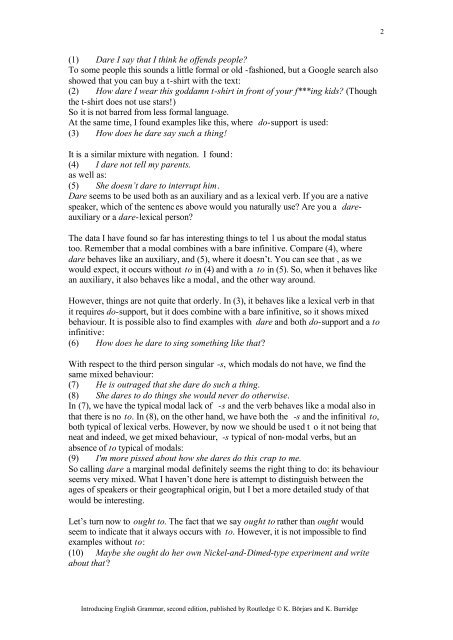Create successful ePaper yourself
Turn your PDF publications into a flip-book with our unique Google optimized e-Paper software.
2(1) Dare I say that I think he offends people?To some people this sounds a little formal or old -fashioned, but a Google search alsoshowed that you can buy a t-shirt with the text:(2) How dare I wear this goddamn t-shirt in front of your f***ing kids? (Thoughthe t-shirt does not use stars!)So it is not barred from less formal language.At the same time, I found examples like this, where do-support is used:(3) How does he dare say such a thing!It is a similar mixture with negation. I found:(4) I dare not tell my parents.as well as:(5) She doesn’t dare <strong>to</strong> interrupt him.Dare seems <strong>to</strong> be used both as an auxiliary and as a lexical verb. If you are a nativespeaker, which of the sentenc es above would you naturally use? Are you a dareauxiliaryor a dare-lexical person?The data I have found so far has interesting things <strong>to</strong> tel l us about the modal status<strong>to</strong>o. Remember that a modal combines with a bare infinitive. Compare (4), wheredare behaves like an auxiliary, and (5), where it doesn’t. You can see that , as wewould expect, it occurs without <strong>to</strong> in (4) and with a <strong>to</strong> in (5). So, when it behaves likean auxiliary, it also behaves like a modal, and the other way around.However, things are not quite that orderly. In (3), it behaves like a lexical verb in thatit requires do-support, but it does combine with a bare infinitive, so it shows mixedbehaviour. It is possible also <strong>to</strong> find examples with dare and both do-support and a <strong>to</strong>infinitive:(6) How does he dare <strong>to</strong> sing something like that?With respect <strong>to</strong> the third person singular -s, which modals do not have, we find thesame mixed behaviour:(7) He is outraged that she dare do such a thing.(8) She dares <strong>to</strong> do things she would never do otherwise.In (7), we have the typical modal lack of -s and the verb behaves like a modal also inthat there is no <strong>to</strong>. In (8), on the other hand, we have both the -s and the infinitival <strong>to</strong>,both typical of lexical verbs. However, by now we should be used t o it not being thatneat and indeed, we get mixed behaviour, -s typical of non-modal verbs, but anabsence of <strong>to</strong> typical of modals:(9) I'm more pissed about how she dares do this crap <strong>to</strong> me.So calling dare a marginal modal definitely seems the right thing <strong>to</strong> do: its behaviourseems very mixed. What I haven’t done here is attempt <strong>to</strong> distinguish between theages of speakers or their geographical origin, but I bet a more detailed study of thatwould be interesting.Let’s turn now <strong>to</strong> ought <strong>to</strong>. The fact that we say ought <strong>to</strong> rather than ought wouldseem <strong>to</strong> indicate that it always occurs with <strong>to</strong>. However, it is not impossible <strong>to</strong> findexamples without <strong>to</strong>:(10) Maybe she ought do her own Nickel-and-Dimed-type experiment and writeabout that?Introducing English Grammar, second edition, published by Routledge © K. Börjars and K. Burridge
















